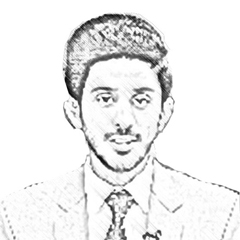If an average Pakistani transgresses into the deep web just for child pornography, he is also deemed to be swayed by other criminal activities.
Human Rights Minister Shirin Mazari recently asserted in the National Assembly that Pakistan was ranked as the country with the largest numbers of child pornography viewers. This got me thinking over this rather vile yet very veracious fact. In the media, this statement has been given a very trifling reservation and has been treated as a meagre topic. However, if made somewhere else, a claim of this pedigree could shake up the entire international community. The inability to recognise the urgency of this topic simply shows the incompetence of our government and higher officials.
The scale of this heinous crime could be examined from seeing the list of Interpol’s most wanted list of Americans, which includes a man known as Willian Lee Copp, a former member of the US Olympic hall of fame. He was caught downloading over a hundred videos of acts of child pornography.
He was seen attending a court appearance in 2006 but not afterwards. In fact, many people on Interpol’s most-wanted list are charged with similar heinous crimes, which actually highlights how sensitive and epoch-making the claim made by Mazari is.
The fact that child pornography is considered an international crime is due to the reason that the age of consent in many countries is eighteen and anyone younger is considered a minor. In the US, the first federal law to ban for-profit production and distribution of child pornography was the Protection of Children against Sexual Exploitation Act of 1977. In response, a US Supreme Court decision allowed the prohibition of child pornography even if it did not meet the obscenity standards established in the three-prong test. Congress passed the Child Protection Act of 1984; broadening the definition of child pornography and criminalising nonprofit child pornography trafficking. The 1986 Meese Report found child pornography was a cause of serious harm. This led to the passage of the Child Sexual Abuse and Pornography Act of 1986, which increased penalties for repeat offenders.
US Supreme Court decision allowed the prohibition of child pornography even if it did not meet the obscenity standards established in the three-prong test. Congress passed the Child Protection Act of 1984; broadening the definition of child pornography and criminalising nonprofit child pornography trafficking
In 1990, a US Supreme Court decision prohibited the possession of child pornography. At the time of this decision, 19 US states had laws on their legislatures to prohibit child pornography possession. As of 2015, all 50 US states had such laws. Provisions of the Child Pornography Prevention Act of 1996, which banned virtual child pornography, were struck down in 2002. Congress passed several laws; increasing the penalties for child pornography offences. In 2003, Congress passed the PROTECT Act; authorizing lifetime terms of federal supervised release for child pornography offenders. Since the US Sentencing Guidelines recommend imposing the maximum term of supervised release for all sex offenders, this means a lifetime term of supervised release is recommended for all child pornography offenders.
It is sadly very enticing to notice that often victims of child pornography are abused by someone they know and might have a sense of trust in them. These offenders have close access to the children they are abusing, using grooming tactics to normalise sexual contact and encourage secrecy.
According to a survey in 2013 made by the National Center for Missing and Exploited Children (NCMEC), content produced by a parent, guardian or a relative constitutes and accounts for 43 per cent. These home-made tapes are not only disgusting but also responsible for making their viewers brainwashed; transfixing them with very disturbing lustful fantasies. They then try to imitate what they see on the screen.
As it is clearly evident that child pornography cannot be found on the World Wide Web and could only be accessed on the deep or dark web, even accessing such porn is considered illegal. Thus, it can also be reasonably inferred from Mazari’s statement that a large number of Pakistanis are also using and accessing the dark web. The dark web constitutes of a plethora of illegal activities from drug trafficking, international hacking forums to even forums related to buying smuggled items for cryptocurrency. So, if an average Pakistani transgresses into the deep web just for child pornography, he is also deemed to be swayed by other mentioned criminal activities.
This can, thus, increase the overall percentage of crime in our country. Being very incompetent and slow, our cyber crime department lacked the technological prowess to pinpoint a deep web user due to the rapid change in the IP address. This is what makes the deep web an ideal place to upload, buy and watch child pornography.
It is urged that the Pakistani government acknowledges this issue and adheres to eradicate this thorn in our national pride in being an “Islamic Republic.”
The government should provide the cybercrime department with advanced and up-to-date technological equipment and servers so that offenders could be easily identified and indefinitely detained. Moreover, our courts should also pass laws against such acts that consist of a severe penalty in the case of violation. The government should also ban the use of dark web servers in Pakistan.
The writer is a journalist and social media activist based in Islamabad.
He tweets @ShahabSpeaks
